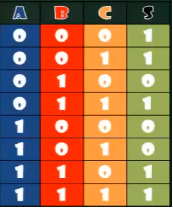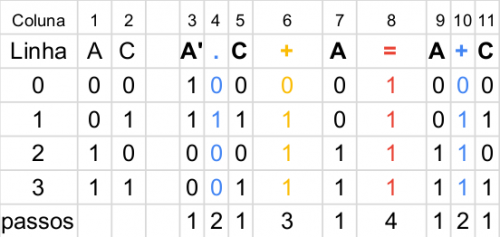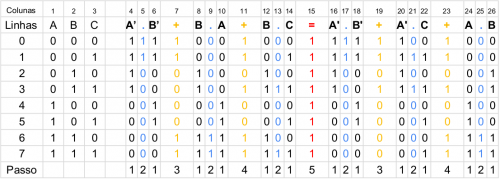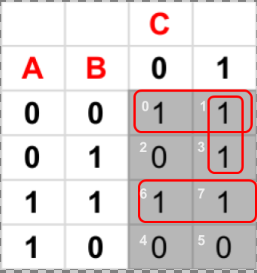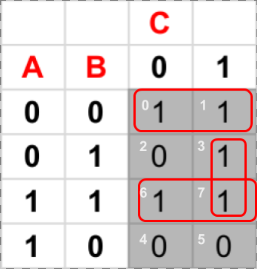Is it correct to state that this boolean simplification is correct?
We have the following table truth :
Just from the minterms its boolean expression is as follows:
A'.B'.C' + A'.B'.C + A'.B.C + A.B.C' + A.B.C
According to this site , it is said that the simplification of its expression is given by:
y = A'.B' + A'.C + A.B
But with my boolean simplification I managed to get the following result:
S = A'.B'.C' + A'.B'.C + A'.B.C + A.B.C' + A.B.C
S = A’.B’(C’ + C) + A’.B.C + AB(C’ + C)
S = A’.B’ + A’.B.C + AB
S = A’.B’ + B(A’.C + A)
S = A’.B’ + B(C.1)
S = A’.B’ + BC
Checking in next website, for the two answers I did not get the same output from the true table.. I am not a doctor to be able to prove and affirm that it is correct and this would be the best solution, but what conclusion should I draw from this?
- a)that my simplification is correct, even different from the other?
- b) that my simplification is better than the other, by using fewer doors?
2 answers
Has an error in your solution when pointing out that:
S = A’.B’ + B(A’.C + A)
S = A’.B’ + B(C.1)
You are implying that A'.C + A = 1 = (A' + A)
A C C.(A'+A)
0 0 0
0 1 1
1 0 0
1 1 1
A C A'.C+A
0 0 0
0 1 1
1 0 1
1 1 1
It is worth noting that A'.B '+ A'.B. C + A. B is also Solution. But somehow, A'.B '+ A'.C + A. B is also.
Answer your immediate questions: a) - - - is my simplification correct, even different from the other? Its simplification is wrong from Line 4 (line that starts its implication A'.C + A = C . 1). Being different from the other does not necessarily imply being wrong.
B) - - - is my simplification better than the other, by using fewer ports? If your answer was correct, yes and your biggest improvement would be by not using a three-input OR port and yes an OR port with two inputs.
Step By Step:
Includes some steps you omitted, as well as points'.'in places like AB, so as to stay, A. B, so as not to leave anything implicit. The comments next to a line concern what I had to do on that line to get to the next line.
Obs. I recommend not to use the point'.'to represent the logical and operation just like the" + " for the OR, this overloads these operators when you is doing arithmetic. I recommend using the " ^ "for the AND and" v " for the OR. In order not to confuse you I did following your way ;)
1. S = A'.B'.C' + A'.B'.C + A'.B.C + A.B.C' + A.B.C /* distributiva AND */
2. S = A’.B’.(C’ + C) + A’.B.C + A.B.(C’ + C) /* elemento máximo OR */
3. S = A’.B’.1 + A’.B.C + A.B.1 (OMITIDO) /* elemento neutro AND */
4. S = A’.B’ + A’.B.C + A.B /* associativa AND */
5. S = A’.B’ + B.A’.C + B.A (OMITIDO) /* distributiva AND */
6. S = A’.B’ + B(A’.C + A) /* por (1) */
S = A’.B’ + B(C.1) /* ERRADO */
S = A’.B’ + BC /* ERRADO */
7. S = A’.B’ + B.(A + C) /* distributiva AND */
8. S = A’.B’ + B.A + B.C /* e isso é equivalente a resposta do site por (2) */
Justification
(1) Test: A'.C + A = A + C
A’.C + A /* associativa OR */
A + A’.C /* distributiva OR */
(A + A') . (A + C) /* elemento máximo OR */
1 . (A + C) /* elemento neutro AND */
A + C
Therefore, A'.C + A = A + C
Proof by The Truth Table:
(to track the proof by the truth table I recommend opening the image in a separate tab)
As there are 2 variables, A and C, 2^2 combinations = 4 combinations.
Passo 1,
Lado esquerdo,
A Coluna(Col.) 3 recebe NEGAÇÃO da Col. 1.
Col. 5 recebe Col.2;
Col. 7 recebe Col.1
Lado direito,
Col. 9 recebe Col. 1;
Col. 11 recebe Col. 2
Passo 2,
Lado esquerdo: Col. 4 recebe AND entre a Col. 3 e 5.
Lado direito: Col. 10 recebe OR entre a Col. 9 e 11.
Passo 3,
Lado esquerdo: Col. 6 recebe OR entre a Col. 4 e 7.
Passo 4,(sinal de igual, nesse caso, representa o operador de equivalência)
Pela definição de equivalência, as colunas 6 e 10 deveriam ser iguais,
fato que acontece. Portanto, está provada a equivalência entre as funções lógicas.
(2) Test: A'.B '+ B. A + B. C = A'.B '+ A'.C + A. B
Proof by The Truth Table:
3 variables A, B, C. 2^3 combinations = 8 combinations
Passo 1,
Lado esquerdo,
Col. 4 recebe a NEGAÇÃO da Col. 1
Col. 6 recebe a NEGAÇÃO da Col. 2
Col. 8 e 12 recebe Col. 2
Col. 10 recebe Col. 1
Col. 14 recebe Col. 3
Lado direito,
Col. 16 e Col. 20 recebem a NEGAÇÃO da Col. 1
Col. 18 recebe a NEGAÇÃO da Col. 2
Col. 22 recebe Col. 3
Col. 24 recebe Col. 1
Col. 26 recebe Col. 2
Passo 2,
Lado esquerdo,
Col. 5 recebe AND entre Col. 4 e 6;
Col. 9 recebe AND entre Col. 8 e 10;
Col. 13 recebe AND entre Col. 12 e 14;
Lado direito,
Col. 17 recebe AND entre Col. 16 e 18;
Col. 21 recebe AND entre Col. 20 e 22;
Col. 25 recebe AND entre Col. 24 e 26;
Passo 3, (Lembre-se que o OR é associativo)
Lado esquerdo,
Col. 7 recebe OR entre Col. 5 e 9;
Lado direito,
Col. 19 recebe OR entre Col. 17 e 21;
Passo 4,
Lado esquerdo,
Col. 11 recebe OR entre Col. 7 e Col. 13
Lado direito,
Col. 23 recebe OR entre Col. 19 e 25;
Passo 5,
Pela definição de equivalência 11 deveria ser igual a 23,
fato que acontece. Portanto, está provada a equivalência
entre essas duas funções lógicas.
Additional
(1) about Gabriel's answer, he erred in saying that you implied that a'.C + a = 1, you didn't do that, what you did is imply that A'.C + A = C.
(2) The reason for what there are several solutions is that in fact there is not a single correct solution. But make no mistake, as was quoted by William A'.B '+ A'.B. C + A. B is also a solution but it is not a "correct solution", in my view, because it can still be simplified.
For this problem there are two correct solutions. Karnaugh's map justifies it.
First:
Second:
Let f be the function represented by these Karnaugh maps then: (first image) f = A'.B '+ A'.C + A. B or (second image) f = A'.B ' + B. C + A. B, respectively the answer you found on the site and the answer we found.
